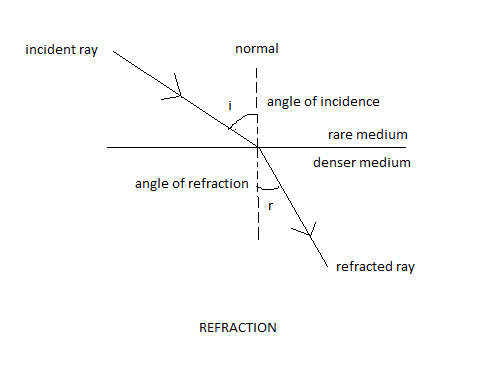
When light travels from optically denser medium to optically rarer medium after refraction ------.
Answer
503.7k+ views
- Hint: The direction of propagation of an obliquely incident ray of light that enters the other medium, changes at the interference at the interface of two media. This phenomenon is called refraction of light. Refraction is that the change in direction of wave propagation thanks to a change in its transmission medium. The phenomenon is explained by the conservation of energy and the conservation of momentum. Due to change of medium, the phase velocity of the wave is modified but its frequency remains constant.
Complete step-by-step answer:

Now moving to question, we have
When light travels from optically denser medium to optically rarer medium, after refraction of light it diverts away from the normal. Therefore, option A. is the correct answer for the above question
Note: Terms related to refraction
Incident ray- the ray which falls on the surface of separation (or interface) to enter into the new medium.
Refracted ray- the ray in the second medium, obtained after refraction.
Normal- imaginary straight line perpendicular to the refracting surface at the point of refraction.
Angle of incidence (i)- angle between the incident ray and therefore the normal
Angle of refraction (r)- angle between the refracted ray and the normal.
When light ray is incident normally, only speed changes and direction of light remains the same. When light ray passes from a rarer medium to a denser medium, it bends towards the normal. When light ray passes from denser medium to rarer medium, it bends faraway from the normal.
Complete step-by-step answer:

Now moving to question, we have
When light travels from optically denser medium to optically rarer medium, after refraction of light it diverts away from the normal. Therefore, option A. is the correct answer for the above question
Note: Terms related to refraction
Incident ray- the ray which falls on the surface of separation (or interface) to enter into the new medium.
Refracted ray- the ray in the second medium, obtained after refraction.
Normal- imaginary straight line perpendicular to the refracting surface at the point of refraction.
Angle of incidence (i)- angle between the incident ray and therefore the normal
Angle of refraction (r)- angle between the refracted ray and the normal.
When light ray is incident normally, only speed changes and direction of light remains the same. When light ray passes from a rarer medium to a denser medium, it bends towards the normal. When light ray passes from denser medium to rarer medium, it bends faraway from the normal.
Latest Vedantu courses for you
Grade 8 | CBSE | SCHOOL | English
Vedantu 8 CBSE Pro Course - (2025-26)
School Full course for CBSE students
₹45,300 per year
EMI starts from ₹3,775 per month
Recently Updated Pages
Master Class 9 General Knowledge: Engaging Questions & Answers for Success

Master Class 9 English: Engaging Questions & Answers for Success

Master Class 9 Science: Engaging Questions & Answers for Success

Master Class 9 Social Science: Engaging Questions & Answers for Success

Master Class 9 Maths: Engaging Questions & Answers for Success

Class 9 Question and Answer - Your Ultimate Solutions Guide

Trending doubts
Give 10 examples of unisexual and bisexual flowers

Draw a labelled sketch of the human eye class 12 physics CBSE

Differentiate between homogeneous and heterogeneous class 12 chemistry CBSE

Differentiate between insitu conservation and exsitu class 12 biology CBSE

What are the major means of transport Explain each class 12 social science CBSE

Why is the cell called the structural and functional class 12 biology CBSE




